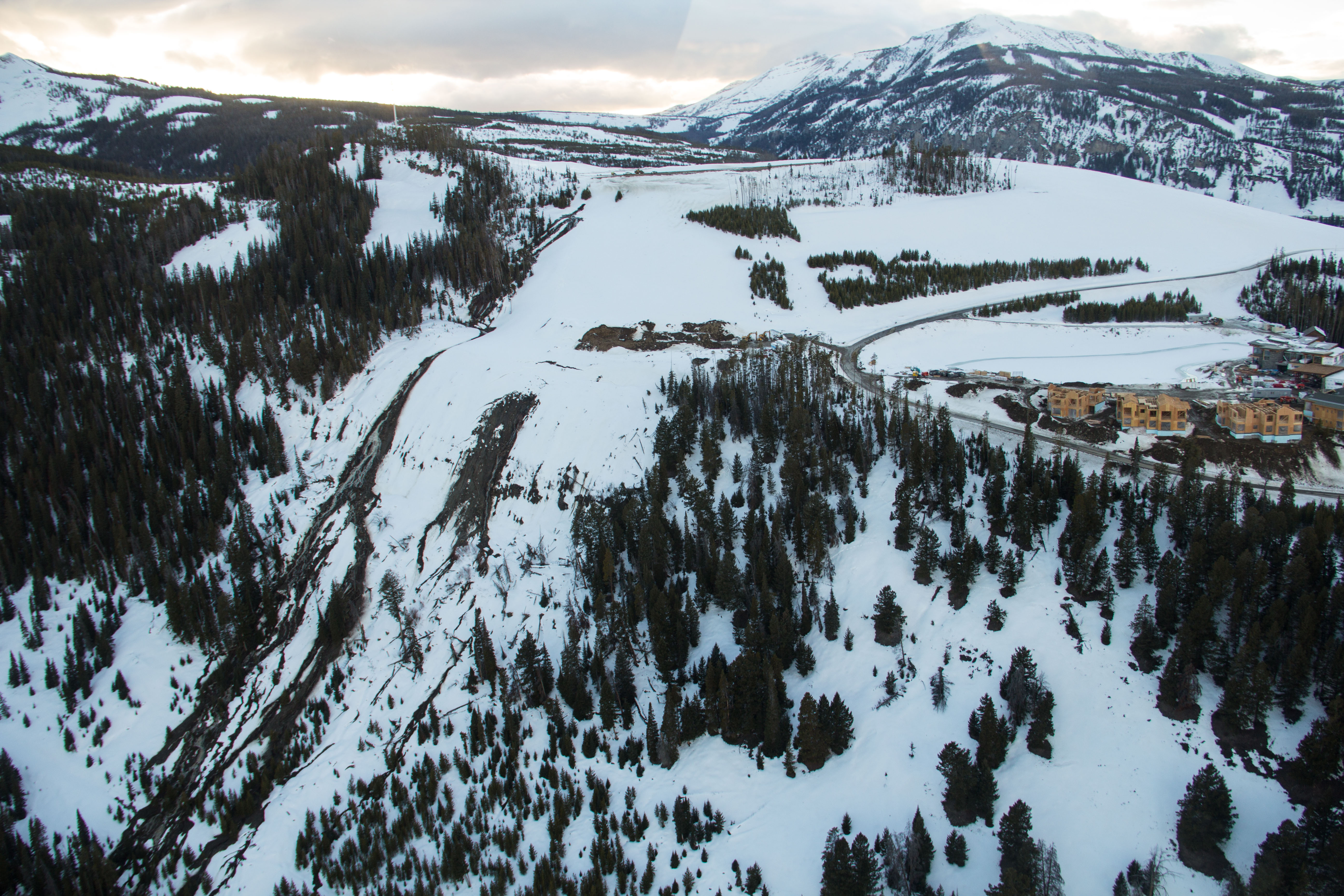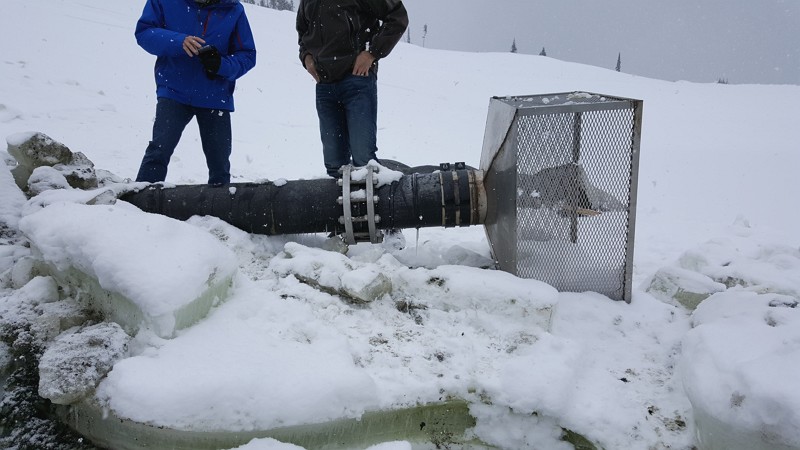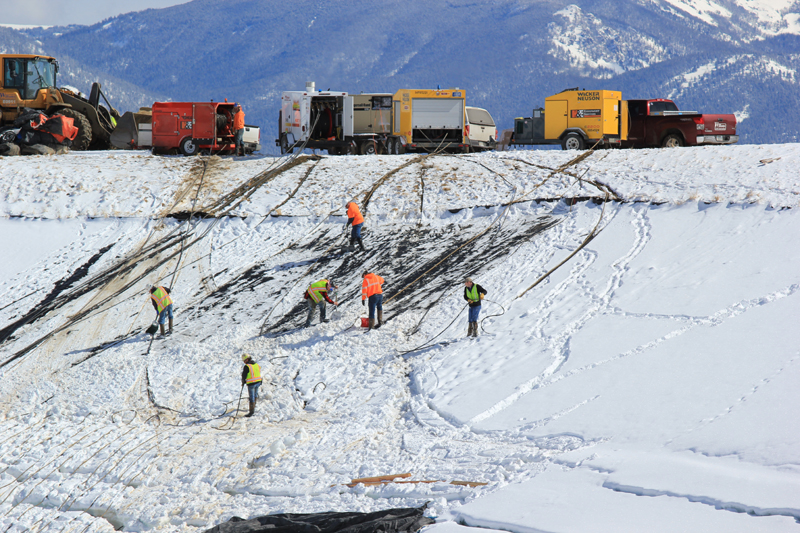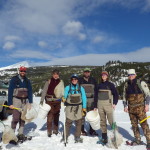Uncategorized
DEQ: 2015 modification to YC wastewater pond may have led to pipe failure, spill
Published
9 years agoon
Posted By
Outlaw Partners
By Amanda Eggert EBS Staff Writer
BIG SKY – According to a March 16 report released by the Montana Department of Environmental Quality, a change made to the inlet screen of the Yellowstone Club wastewater pond last year might be responsible for the pipe failure that led to the discharge of 30 million gallons of treated effluent into the Gallatin River in early March.
The pond, which was constructed in 2005, has twice been repaired for leaks in the past two years.
According to the report, Yellowstone Club officials notified DEQ in August 2012 that the pond was leaking at a rate of approximately 15 gallons per minute – a big enough leak to merit DEQ notification according to the agency’s standards.
DEQ advised the Yellowstone Club to drain the pond down “within a couple of years” to evaluate and fix the problem, according to the March 16 report. No enforcement actions against the Yellowstone Club were taken at that time, according to Kristi Ponozzo, public policy director of Montana DEQ.
In summer 2014, the pond was completely emptied and inspected. Several small punctures in the liner, along with a tear in the liner boot at the base of the outlet pipe were found. The original liner installation company made the necessary repairs, according to Ponozzo.
The pond was drained again in 2015 because it was still leaking, at an estimated rate of 4 gallons per minute. A tear was found at the same liner boot location and the boot was reinforced by a local pond contractor, who reported that the previous fix may not have been done properly.
In a March 15 email to EBS, Ponozzo wrote, “At this time, the YC operator attached clamps to the inlet screen in an effort to eliminate the annual process of retrieving and reinstalling the screen (believed to be lifted by the ice each year) onto the top of the outlet pipe.
“We believe the clamps may have contributed to the severing of the outlet pipe,” Ponozzo continued.
Yellowstone Club Vice President of Development Mike DuCuennois wrote in a March 16 email, “Several issues played into the failure of the liner. [Yellowstone Club], engineers and the DEQ have all inspected the site and have made the determination that ice definitely played a role in this. It is not totally known if the ice pulled the pipe or the screen or all of it together.”


The damaged screen that was found at the bottom of the pond. PHOTOS COURTESY BIG SKY WATER AND SEWER DISTRICT
According to Ponozzo, the DEQ was unaware of the addition of the clamps until recently. They were not involved in the 2015 repair because the pond was not discharging at a rate meriting their oversight.
The DEQ approves designs for wastewater ponds like the Yellowstone Club’s before initial construction, but does not conduct routine inspections.
“We do not do inspections on these ponds for a number or reasons, mostly related to staffing and budget and just our regulatory role in these wastewater ponds,” Ponozzo said in a phone interview.
She said DEQ is reevaluating its role in such inspections. “We are looking at the importance of potential inspections and what it might involve for DEQ to take on that regulatory role. We are also looking into risk and whether this incident was an anomaly, or if inspections are something we need to prioritize,” she wrote on March 15.
The Yellowstone Club and DEQ have been moving forward with the pond’s repair. On March 11, engineers submitted a repair plan to the DEQ. Following DEQ’s recommendation, the Yellowstone Club revised and resubmitted their plans and expected to get approval to continue repairs by March 18.
DuCuennois said he expects it will take about six days to complete the repair once the necessary DEQ approval has been secured.


A response team enters the emptied wastewater pond March 7.
——-
Impacts to fishery uncertain
Although a number of organizations have taken samples of the Gallatin River and its tributaries impacted by the spill, limited results were available when EBS went to press March 16.
DEQ collected water samples at 10 sites in the Gallatin watershed and sent them to Energy Labs in Helena for analysis. DEQ is testing for phosphorus, ammonia, pharmaceuticals, nitrate plus nitrite, and total nitrogen. These samples are still being analyzed and DEQ expects to have a full report “in the coming weeks,” according to Ponozzo.
DEQ also monitored turbidity, a measurement that reflects the amount of suspended sediment in the water. On March 11, the agency reported that by March 9, turbidity returned to pre-spill levels on the Gallatin River, but was still elevated in impacted tributaries including Second Yellow Mule Creek, and the South Fork of the West Fork of the Gallatin.
Turbidity levels far exceeded DEQ thresholds in the first days of the spill, and Ponozzo said the DEQ is working on an enforcement action against the Yellowstone Club for Water Quality Act violations. It’s a several-month-long process, she said.
Preliminary E. coli results from samples collected March 7 indicate that E. coli, a type of bacteria found in the feces of warm-blooded animals, was detected.
“There were no [E.coli] exceedences of the state’s water quality standards at any of DEQ’s ten sampling sites,” Ponozzo wrote, adding, “The actual results for each site will be presented in a more detailed report that will be available later this week.”
Kristin Gardner, executive director of Gallatin River Task Force, said E. coli tests can come back positive due to the impact of wildlife. “Generally speaking, that [Yellowstone Club] pond tests negative for E. coli most of the time that they test it,” she said.
GRTF also took water samples in the days after the spill. The organization has received some results, is analyzing it against historical data, and will write a report once the analysis is complete.
——


The electrofishing team that evaluated trout health on the South Fork of the West Fork of the Gallatin after the spill. PHOTO COURTESY GALLATIN RIVER TASK FORCE
Two GRTF employees assisted with fish population March 10, joined by a Confluence Consulting project manager and six Montana Fish, Wildlife and Parks employees.
Dave Moser, a fisheries biologist with FWP, said the team hiked into the confluence of Second Yellow Mule Creek and the West Fork of the South Fork of the Gallatin to electrofish four sections of water, one upstream of the confluence and three downstream of it, on March 10.
They found five westslope cuththroat mortalities just downstream of the confluence. The mortalities likely came out of Second Yellow Mule Creek, Moser said in a phone interview.
“The first quarter mile [beyond the confluence] there were definite effects,” Moser said. “Whether it was displacement or mortality, I don’t know.”
The team found approximately 90 cutthroat per 100 meters upstream of the confluence, 30 directly downstream of it, and 140 a quarter-mile downstream.
“It’s a snapshot in time,” Moser said of the surveys the team conducted. “The trout seem OK, but there’s still all that sediment in there and potentially nutrients we won’t know [about] until we do further sampling.”
Guy Alsentzer, executive director of Upper Missouri Waterkeeper, wrote in an email to EBS that it’s important to remember that some deceased fish may have flushed downstream given the significant amount of water moving through tributaries during the discharge.
He also said long-term impacts from the spill – like increased sedimentation and decreased dissolved oxygen – won’t be known for some time. “Recent surveys alone do not fully characterize the spill’s impacts,” Alsentzer wrote.
Moser said there’s still a plug of sediment that might come down Second Yellow Mule during spring runoff. The wastewater spill was different from other spring runoff events into the Gallatin – like the sediment release that regularly happens from the Taylor Fork – because of its abrupt nature.
“In a normal spring runoff event, you don’t have a large amount of sediment that is [suddenly] dropped out and fills those voids in the stream,” he said. “Hopefully spring runoff will flush those out and the stream will go back to its previous quality.”
Moser plans to return in the summer and fall to collect more data on the long-term impacts on the Gallatin’s fisheries.
According to Moser, people don’t give fish enough credit for their resilience. “They’re pretty tough,” he said. “It’s one of those things, time will tell.”
The Outlaw Partners is a creative marketing, media and events company based in Big Sky, Montana.


Upcoming Events
november, 2024
Event Type :
All
All
Arts
Education
Music
Other
Sports
Event Details
Spanish Classes with World Language InitiativeThese unique, no cost Spanish classes are made possible by the contribution of Yellowstone Club
more
Event Details
Spanish Classes with World Language InitiativeThese unique, no cost Spanish classes are made possible by the contribution of Yellowstone Club Community Foundation (YCCF) and Moonlight Community Foundation (MCF). This class will focus on building a lifelong affinity for world languages and cultures through dynamic and immersive Communicative Language teaching models.
Beginner Class – Mondays and Wednesdays from 5:30-6:30 pm
Intermediate Class – Mondays and Wednesdays from 6:45- 7:45 pm
- Classes begin Oct.7, 2024 and run for 6 weeks
- Class size is limited to 12 students
- Classes are held in Big Sky at the Big Sky Medical Center in the Community Room
For more information or to register follow the link below or at info@wlimt.org.
Time
October 21 (Monday) 5:30 pm - November 27 (Wednesday) 7:45 pm
Location
Big Sky Medical Center - Community Room (2nd Floor)
Big Sky Medical Center - Community Room (2nd Floor)
Event Details
Spanish Classes with World Language InitiativeThese unique, no cost Spanish classes are made possible by the contribution of Yellowstone Club
more
Event Details
Spanish Classes with World Language InitiativeThese unique, no cost Spanish classes are made possible by the contribution of Yellowstone Club Community Foundation (YCCF) and Moonlight Community Foundation (MCF). This class will focus on building a lifelong affinity for world languages and cultures through dynamic and immersive Communicative Language teaching models.
Beginner Class – Mondays and Wednesdays from 5:30-6:30 pm
Intermediate Class – Mondays and Wednesdays from 6:45- 7:45 pm
- Classes begin Oct.7, 2024 and run for 6 weeks
- Class size is limited to 12 students
- Classes are held in Big Sky at the Big Sky Medical Center in the Community Room
For more information or to register follow the link below or at info@wlimt.org.
Time
October 28 (Monday) 5:30 pm - December 4 (Wednesday) 7:45 pm
Location
Big Sky Medical Center - Community Room (2nd Floor)
Big Sky Medical Center - Community Room (2nd Floor)
Event Details
Spanish Classes with World Language InitiativeThese unique, no cost Spanish classes are made possible by the contribution of Yellowstone Club
more
Event Details
Spanish Classes with World Language InitiativeThese unique, no cost Spanish classes are made possible by the contribution of Yellowstone Club Community Foundation (YCCF) and Moonlight Community Foundation (MCF). This class will focus on building a lifelong affinity for world languages and cultures through dynamic and immersive Communicative Language teaching models.
Beginner Class – Mondays and Wednesdays from 5:30-6:30 pm
Intermediate Class – Mondays and Wednesdays from 6:45- 7:45 pm
- Classes begin Oct.7, 2024 and run for 6 weeks
- Class size is limited to 12 students
- Classes are held in Big Sky at the Big Sky Medical Center in the Community Room
For more information or to register follow the link below or at info@wlimt.org.
Time
November 4 (Monday) 5:30 pm - December 11 (Wednesday) 7:45 pm
Location
Big Sky Medical Center - Community Room (2nd Floor)
Big Sky Medical Center - Community Room (2nd Floor)









